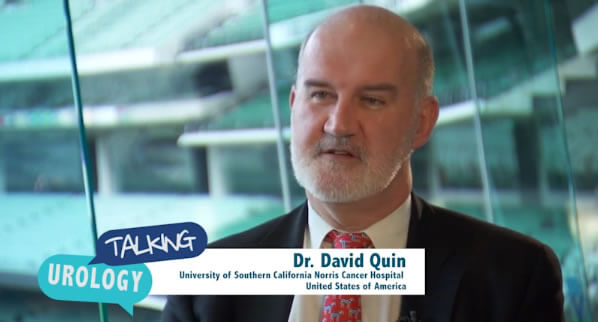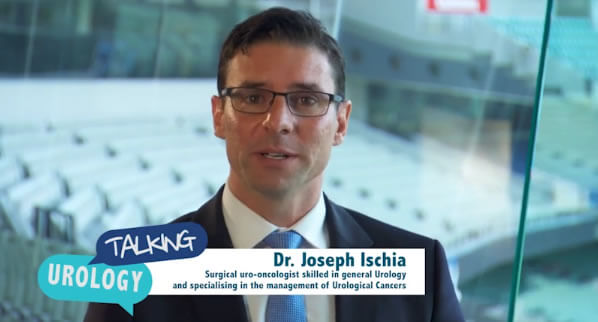ANZUP 2017 – Dr Camille Short
Dr Camille Short discusses her innovative website to support men underoging treatment for metastatic prostate cancer.
Talking Urology podcast transcript
ANZUP 2017 Interviews - Haryana Dillon and Camille Short
Haryana Dillon: I’m Haryana Dhillon and I’m here with Camille Short from Adelaide and we’re going to talk about Cam’s website which is designed to support men with prostate cancer. Do you want to tell us about what it’s for and what you’re doing with it?
Camille Short: We’re in the process of designing a website for men with metastatic disease. I specialize in this technique called computer tailoring. It’s essentially, you have an assessment and then you have added algorithms and you match the messages that you’ve kind of already pre-created in the website with people’s responses to the survey which kind of a complicated way of saying that we tailor the information, put it in an automated process and that’s usually done for behavior change interventions where you’re trying to influence things like intentions and social support. I’m just trying to help people stay motivated. I guess it’s similar to what Fitbit might do, but a little bit more heavy on the exercise psychology. What we’re trying to do is actually work with exercise physiologists from Edith Cowan to not just focus on behavior change but also exercise prescription. Obviously, men with metastatic disease have a really high need for specialized support, so what the website is really designed to do is to try and increase the reach of that level of expertise, so that you can get exercise advice that’s tailored based on, say, the extent and location of your metastases.
Haryana: When you start talking about exercise prescription, what does that mean?
Camille: Good question. What I really mean is the personalization of an exercise program. Usually, I think of the fit principles, so that’s frequency, intensity, time and type. When you’re prescribing exercise, you are making sure that that type of exercise that you’re recommending to somebody fits their unique needs and also goals. You would be specifically focusing on health outcomes like strength, endurance and aerobic fitness and then tailoring the fit components of the exercise for them. And so, typically, websites tend to focus on the public health guidelines or the guidelines for cancer survivors. That would be 250 minutes a week of moderate intensity activity and two resistance training sessions. Whereas what we’re trying to do is a lot more tailored, so that people will be able to log on and kind of tell the system their circumstances and their health profile. And then, you actually get some videos which is a kind of crazy thing to do on the back end because it means that you have to record hundreds of snippets of different videos and then we generate the algorithms that bring them all together into a seamless videos, so from the user’s point of view, it’s like their own personal YouTube video specifically made for them actually demonstrating what exercises to do.
Haryana: Alright, that sounds really cool. Are the algorithms pretty complicated?
Camille: They are as complicated as I can be, so yes, they can be infinitely complicated. Every time you want to tailor on a variable, you increase the number of messages. If I say that there are two age groups and two genders that we want messages for, then there’ll have to be four separate messages. If you can imagine that you are looking at Demographics x Psychosocial variables x Cancer history, you can end up— and then all the different permutations of that in a decision tree that if they’re older and they have this and they have that, then that, they can get fairly complicated.
Haryana: Okay. And the other question I was going to ask you is what kinds of characteristics do you tailor based on?
Camille: Traditionally in the programs I’ve done for people who are generally well, it has been mostly tailored to try and increase motivation and help people, I guess, self-management skills. And so, we tailor a lot on their demographics because the aim is to make people process information more thoroughly when it’s relevant to them. And so, we make sure that it’s relevant to their age and their gender and their location. People in a city area would get different types of messages to people in a rural area. When you’re talking about physical activity promotion, we wouldn’t tell them to get off the bus 30 minutes earlier, iff they live on a farm that kind of stuff, so it just…
Haryana: Doesn’t quite work yet.
Camille: Yes. We take out all the irrelevant components by tailoring on demographics, but then I have a psychology background, so we tailor on a lot of what we think are the most important things for influencing behavior, so that’s things like people’s self-advocacy of confidence. Someone who’s really confident to go ahead and get started will get kind of different messages and support to someone who needs a little bit more help, and level of social support is probably the other main thing. And then, with the cancer populations, we also tailor on health status. Some of my PhD work was on women with breast cancer, so that would be whether or not they have lymphedema, a whether or not they have osteoporosis, that kind of stuff.
Haryana: All of the things that are going to impact on their ability to exercise and maybe their willingness to do that.
Camille: Yes, so essentially trying to pretend that we have a psychologist and an exercise physiologist in the room and almost emulate the types of questions that they would ask and then the advice that they would provide, not to replace them but to try and extend that care, so that it’s also available on the internet.
Haryana: Okay, that sounds really fantastic and a potentially great resource for people to be able to access. If you’re a man with metastatic prostate cancer right now, can they access your program?
Camille: Not yet but they can definitely help us design it. We have the software available. We’re just finishing off a large NHRMC trial where we’ve use tailored videos in the general public. And so, we’re using that software in this setting and we’re working with Daniel Cavallo and Rob Newton from Edith Cowan University. They’ve already got a face-to-face program for men with metastatic disease, and so we’ll be putting in the next coming months we have someone from Canada working with us who has an exercise background as well to try and translate into an online environment. What we want to do in the first instance is get some men into the lab and have their feedback on it and also just make sure that they can actually perform the exercises safely based on the video instructions and have that system audited to make sure that their exercise descriptions are actually appropriate.
Haryana: Okay, so that sounds like a really important component because what you’re really talking about is prescribing an intervention or a kind of medicine to patients and making sure that it’s actually safe to do that in this population.
Camille: Yes. And the focus is really different for me, so I’ve not ever designed this type of program for people who are terminally ill before, so the psychology behind it is really different and we need to make sure we need to have consumer input to make sure that the tone— and that it is useful because it’s not so much about— often this is about recovering and living well and it’s obviously still trying to be about living well but we have to be aware of people’s priorities and that they don’t have much time and that this isn’t like a Gung-ho thing it’s just there to support them and make sure that they have the information because when we think that it will help their physical functioning and their quality of life.
Haryana: Okay. Sounds fantastic. And so, now I believe that you’re also going to be one of the recipients of the Below the Belt Pedalthon funding.
Camille: Yes. If I find I am allowed to confirm?
Haryana: I think you’re allowed to confirm that now.
Camille: Yes. Which is an amazing opportunity for me. The director of our center is being involved in the prostate CRE, that’s the prostate cancer survivorship. I guess I’ve been kind of brought in as a junior investigator, as an affiliate, and they’ve been really supportive. A couple of people in the CRE are involved in the project, so it’s a really good opportunity for me as an ACR to have more senior input across the disciplines. It really is a multidisciplinary project, so yes, it’s a good opportunity.
Haryana: Well it sounds fantastic and thanks for talking with us and we look forward to hearing about the results of your study at one of the future ANZUP meeting.
Camille: Thank you. Thank you Hary.












